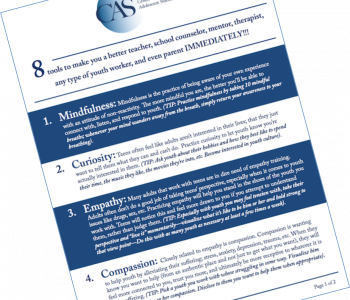

catharine hannay, ma
Catharine Hannay is the founder of MindfulTeachers.org and the author of Being You: A Girl’s Guide to Mindfulness, a workbook for teen girls on mindfulness, compassion, and self-acceptance.
4 Tips for Coping with Burnout and Exhaustion
The expectation that we can be immersed in suffering and loss daily and not be touched by it is as unrealistic as expecting to be able to walk through water without getting wet.
Kitchen Table Wisdom, Dr. Rachel Naomi Remen, p. 52
2020 was an overwhelming year for anyone who works in health care, counseling, or education. As committed as you are to your work, it can be challenging to keep helping others while also caring for your family and worrying about your own health and safety. (And ‘challenging’ is putting it mildly.)
When I first started writing this post, I was trying to figure out the best way to explain the differences between burnout and compassion fatigue; compassion fatigue and vicarious trauma; and vicarious trauma and empathic distress.
Burnout? Compassion fatigue? Empathic distress? Vicarious trauma, not to mention primary trauma? You’re likely experiencing all of those simultaneously, on top of sheer physical exhaustion. We can leave the nuanced distinctions for another day.
Whatever specific issues you’re dealing with, here are four tips that can help you feel calmer in the midst of the chaos. If it seems appropriate, you might also want to share them with your patients, students, or clients.
Tip #1: Focus on What You Can Control
There are all kinds of factors beyond your control, but if you get creative, there are probably a lot of small ways you can make things a bit easier on yourself.
For example, my husband needs to make phone calls right when I need silence so I can concentrate on what I’m writing. So I put on the noise-blocking earmuffs he uses while mowing the lawn. I may look a bit silly wearing them in the house, but frankly that’s not the level of problem I’m worried about these days.
Tip #2: Take a Quick Pause Before Reacting
Between stimulus and response there is a space. In that space is our power to choose our response. In our response lies our growth and our freedom.
Victor Frankl
It only takes a few seconds to stop yourself from reacting out of fear, stress, anger or frustration, so you can deescalate a tense encounter, calmly advocate for yourself, make a challenging decision, or recombobulate yourself when you’re feeling discombobulated.
There are a lot of acronyms for taking a mindful pause. PAUSE, for example. Or PEACE. I think the best one is TAP. (Hey, you’re busy. Why use five letters when you only need three?)
TAP was developed by Dr. Sam Himelstein, the director of the Center for Adolescent Studies. It stands for:
T: Take a breath.
A: Acknowledge.
P: Proceed.
Here’s a theoretical example of how this might work:
Take a breath and pause for a moment to calm down when you’re feeling overwrought.
Acknowledge that you’re having a tough time because of the holidays and the birthdays of a couple of family members who’ve died.
Proceed to a quiet place where you can grieve for a while.
I think we can all agree that practicing TAP would be preferable to snapping at your spouse then bursting into tears for no apparent reason. (Again, this is just a theoretical example. And no, you are not allowed to ask my husband what happened on December 20th).
Tip #3: Try a Body Scan or Progressive Relaxation Practice
If you’ve been feeling very tense or having trouble sleeping, try a body scan or progressive relaxation. These are similar practices; the basic difference is that in a body scan, rather than trying to relax, you just notice whatever sensations are already there.
Here’s a progressive relaxation practice that memoirist Amy Kurzwell uses to help her fall asleep:
First, lie down on your back, or in whatever position is most comfortable for you.
You start to reeelax…
First your feet, then your calves.
Relax your knees and the tops of your thighs.
Relax your hips and your stomach and your chest.
Shoulders and elbows and fingers…
Your neck and your head
from your chin to your nose
to the tips of your ears.
Your eyelids, your brows
even your hair from root to tip.
Until everything is safe
Your mind is calm
Your breathing is slow and deep.
Flying Couch: A Graphic Memoir, p. 292-293
You also might want to try either the 10-minute or 30-minute body scan by Dr. Dzung Vo at MindfulnessforTeens.com (Dr. Vo’s guided meditations are suitable for youth or adults.)
Tip #4: Move Your Body to Rest Your Mind
When I’m caught up in anxiety and rumination, my favorite way to clear my head is through a practice I call Rainbow Walk.
Take a stroll, and look for something in each color of the rainbow: perhaps a red stop sign, the orange pumpkin on someone’s front porch, a bright yellow car, a green pine tree, a dog with a blue sweater, and a kid in a purple hat. Then keep looking for the colors again and again throughout your walk.
We all have different circumstances and preferences, so here are a few variations:
- If you’re stuck indoors, you can do a Rainbow Walk in your house or apartment, walking in slow loops around whatever space you have available.
- Your ‘Rainbow Walk’ doesn’t even have to be a walk. You do this in a wheelchair, or while riding in a car or on public transportation. (I don’t recommend doing this while driving because it’s too distracting. Instead, try Red, Orange, Yellow: A Mindful Driving Practice.)
- If you’re colorblind, visually impaired, or simply want to try another option, you could do a ‘Counting Sounds’ walk instead.
Conclusion: Moments of Calm in the Midst of Chaos
Difficult things have happened; difficult things will happen. […] Still, everything is okay right now […] for one second. And another second. And I can put enough of these seconds together to make minutes. There are minutes when I’m allowed to feel okay, not despite everything that’s happened or will happen, but in addition to it.
Everything is an Emergency, Jason Adam Katzenstein, p. 101
Thank you for working so hard to help the youth in your care. I hope these suggestions help make things a bit easier for you during the oddest and most stressful times in living memory.
There are many more posts on self-care for the helping professions at MindfulTeachers.org, including:
- Five Self-Care Tips for Coping During the Pandemic
- Five Mindfulness Practices for Challenging Times
- Four Quick Self-Care Tips for Teachers and Students
You can also find more self-care resources at the Center for Adolescent Studies blog and in the HeartSpring Community for Helping Professionals.

